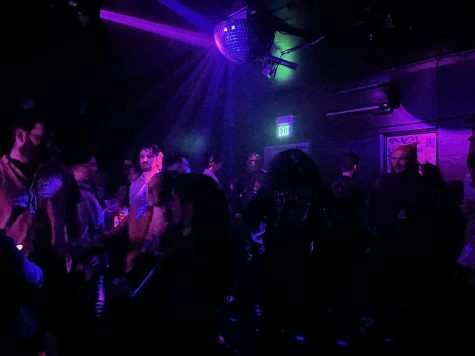Paint or Pixels? The AI Art Debate
Eian Gil: The art world is constantly evolving and that’s all thanks to the new tools becoming accessible to artists. But as more tools and technology are being used to pave the way, new controversies are popping up. Artwork created by Artificial intelligence is an especially divisive subject. Thanks to relatively new developments that allow for just about anyone to create something beautiful within seconds, the question of what the future might hold for AI artwork is more relevant than ever.
So, is the inclusion of this technology just a trend? Or does it represent a natural progression? And more importantly: should we be worried?
I’m Eian Gil, and you’re listening to The Bleed.
In my search for answers, I mainly found myself talking to professionals and artists who have the most experience dealing with these types of artwork in exhibitions and galleries. It really got me thinking on the ethics of some of these new mediums, but that’s something I’ll get to later.
The first person I spoke to to learn more about this subject is Kevin B. Chen. He’s a lecturer at SF state, and the resident curator for the Fine Arts Gallery on campus. Chen has been working as an artist and curator for over 20 years and he invited me to have a conversation with him inside of the gallery at the end of the day. After talking for a bit, Chen told me that we need to tread carefully when it comes to this tech.
Kevin B. Chen: When you get to the point of, of just the whole culture of deep fakes. That becomes really slippery, and really, really complex territory to try to unpack. What happens if someone were to do an AI version of your mother, like, I don’t mean to sound crass, but being in a porno movie.
EG: Chen has had experience curating exhibitions all over the Bay. He’s kind of seen it all at this point.
So I asked Chen if he had any thoughts on tech-based exhibits that might be considered trendy attempts at gaining attention. His response was showing me a video of an art installation by Jordan Wolfson, who’s known for his intense and unsettling pieces.
KC: Here, here’s where they start thrashing him around. This installation too, it actually trained it where it was actually motion sensitive, wherever the sensor is, where this crazy creepy kid would actually find you in the gallery and stare at you.
EG: The doll is bound by heavy metal chains, and through a system of pulleys, is thrashed around while a terrifyingly calm music and monologues play in the background. Art-tech Installations like this one are pretty common in the Bay Area.
KC: And, you know, it’s incredibly violent. It’s got the spectacle for it.
EG: After hearing him refer to the installation as a “spectacle”…. I was interested in hearing an artist’s perspective. I was wondering: would a traditional artist be pissed at the idea of being less popular than a robot or something made by a computer? Can a seemingly regular drawing still be impactful without complex mechanical components and lines of code?
Richy Barnes: Yea. I feel like everything speaks to people differently, so it’ll have the same value. Maybe not to the same people, but it’ll have the same value.
EG: That was Richy Barnes, an art student near the Sacramento area who’s experienced in traditional art. From what he tells me, he’s never been drawn to technology in the way other artists are, but it doesn’t seem like he’s that bothered by its increasing prevalence in galleries.
RB: I’ve been an artist for as long as I can remember. I typically work with traditional mediums like charcoal, or just pencil and paper.
EG: From what he tells me, Barnes’ never been drawn to technology in the way other artists are, but it doesn’t seem like he’s that bothered by its increasing prevalence in galleries. I showed him portraits created by AI that sold for thousands of dollars.
RB: I don’t think it taints the value or impactfulness, I think there’s room for everything to breathe and have meaning…cause I feel like there is a shock value, but with that shock value, there’s also value…so, it still means something.
EG: So both Barnes and Chen agree that the main purpose of AI art and pieces like it is to get attention — to create a spectacle that draws people in.
But here’s the part where I bring up the fact that there are a lot of different types of art, and even more types of artists. It should be noted that, even though Barnes and Chen agree that these types of mediums are being used a certain way, there is still a lot more to say on the subject. Particularly when it comes to the other parts of the working world who benefit from these AI tools. AI is an incredibly valuable resource that continues to develop, and I’m sure a lot of artists benefit from it in more ways than the ones I’m discussing here. When it’s not being used to rival the classics you normally see on the walls of museums, these AI tools are often used to help an artist lay out rough sketches, increase production speed for animators and even to just serve as a reference point for portraits.
EG: So, now that we’ve learned what purpose the art serves to our sources, I had to know: Is it really ethical to put these works of art, created in seconds by a computer, up next to a painting that someone spent their whole life training and practicing to make?
KC: It’s the spectrum of labor versus end result, right? That’s where people start forming opinions.
EG: Chen says you have to remember that young artists are mad because they might be working three different jobs just to pay rent – on top of having to find time to make their own work.
KC: Why is it that they’re pissed off? There’s money attached to this. If that person actually gets invited to go and be part of a museum show, that’s a reputation kind of thing, like, what the hell? I mean, I just think that’s the day and age that we’re living in.
EG: It looks like we have a lot to look forward to as we gain access to even more tech tools we might have never thought possible. Innovation will have to continue no matter what, so let’s just hope it doesn’t get too crazy. Sometimes, bold statements sound a lot bolder without the heavy machinery.
I’m Eian Gil and you’ve been listening to The Bleed.

Eian Gil (he/him) is a journalism & political science student at SF state, currently serving as Xpress magazine’s editor-in-chief. Originally from...



